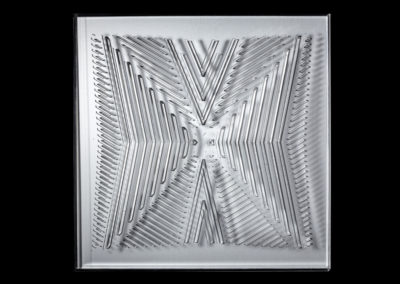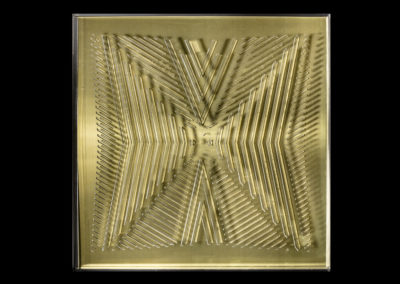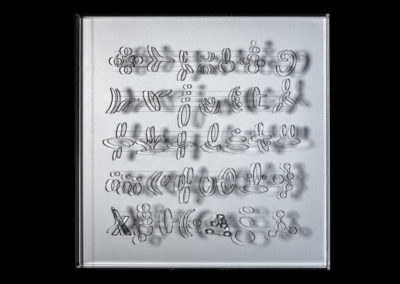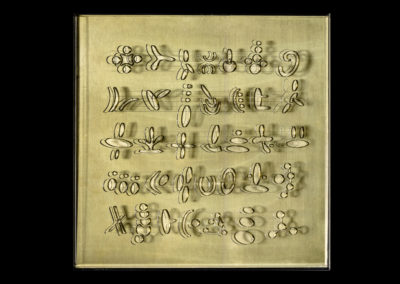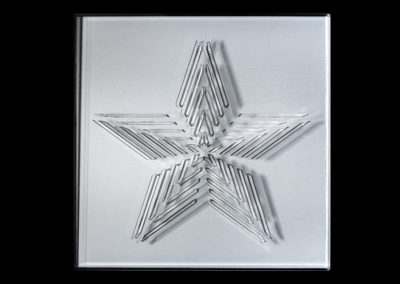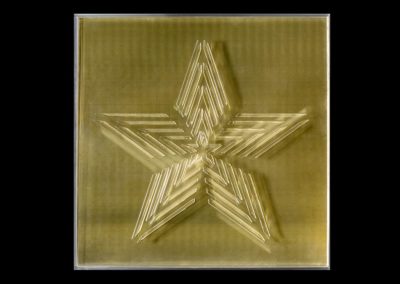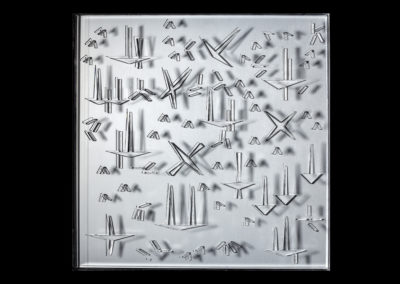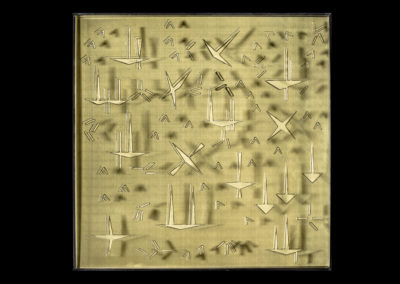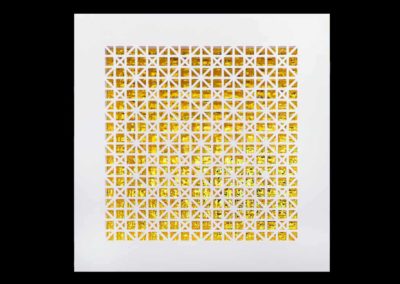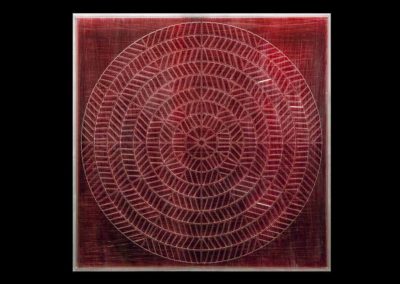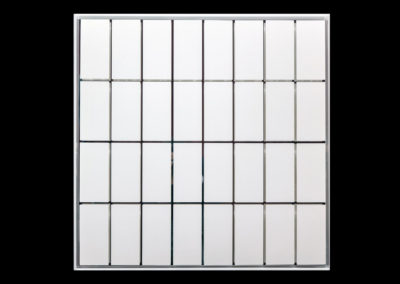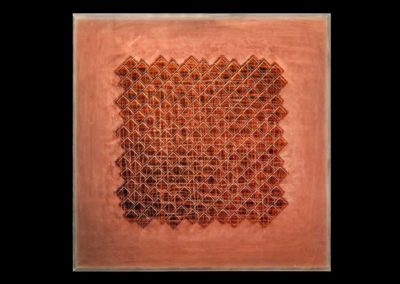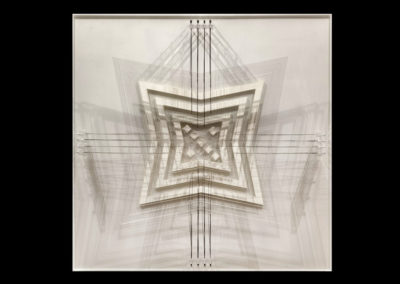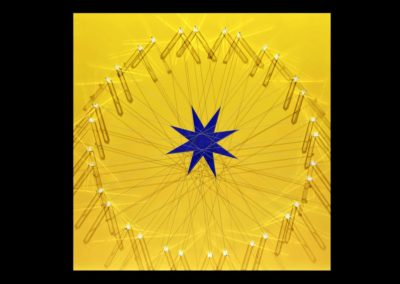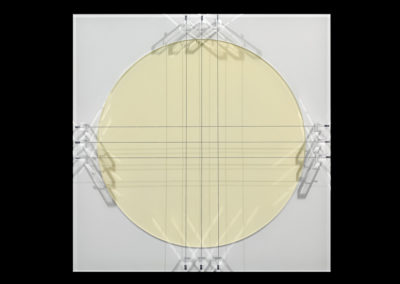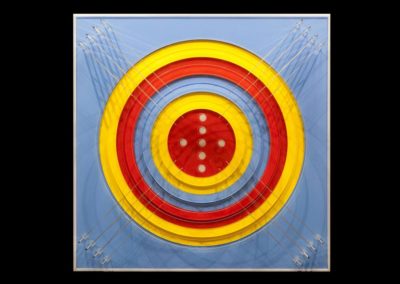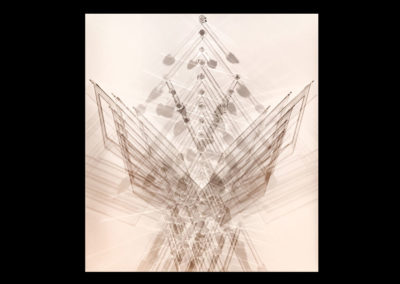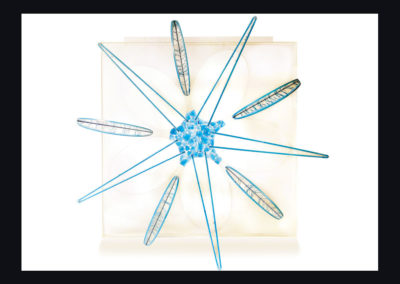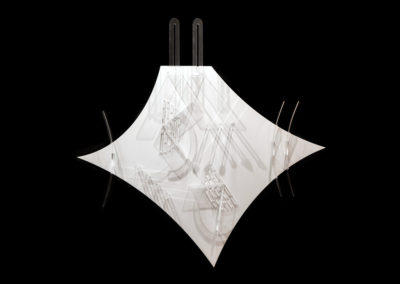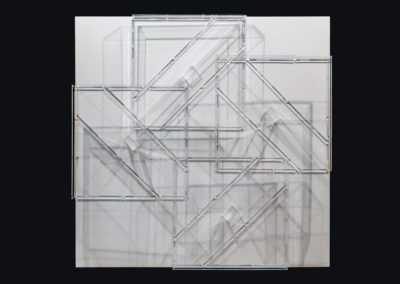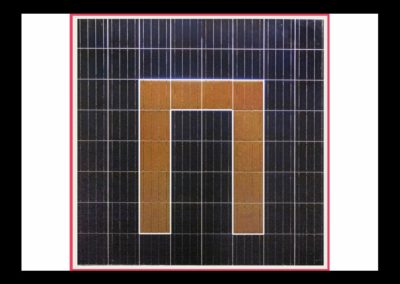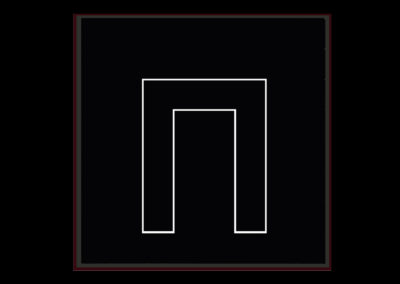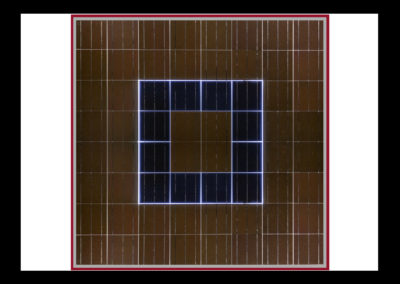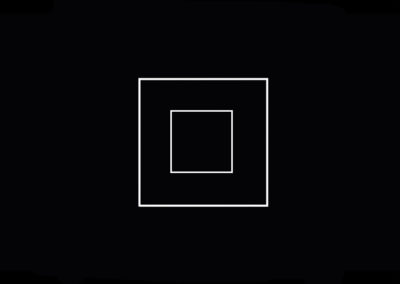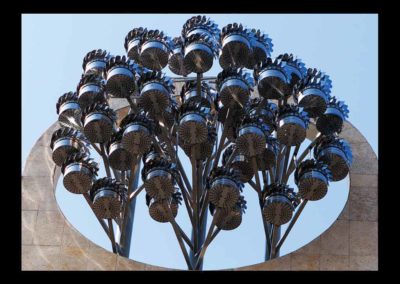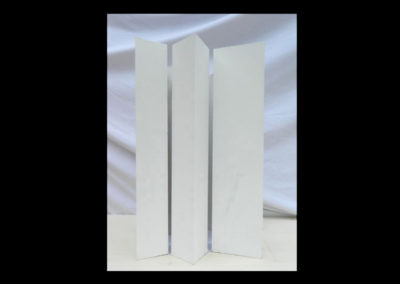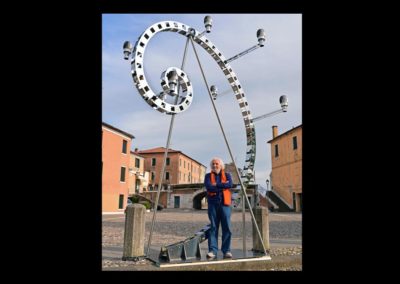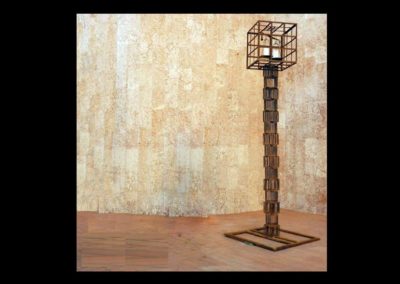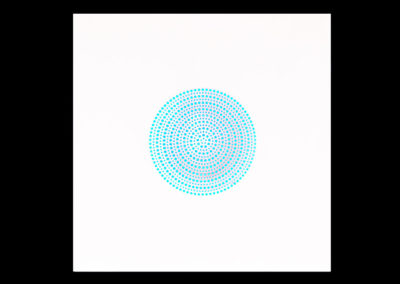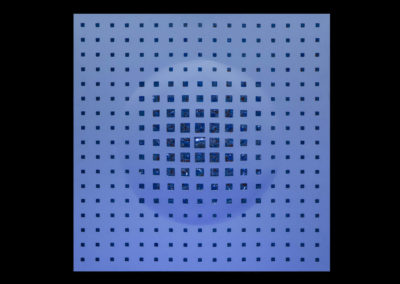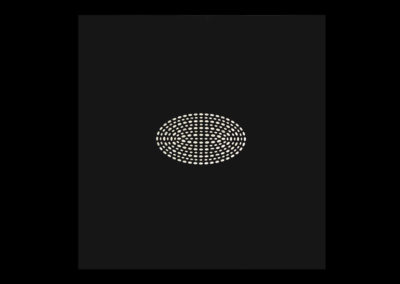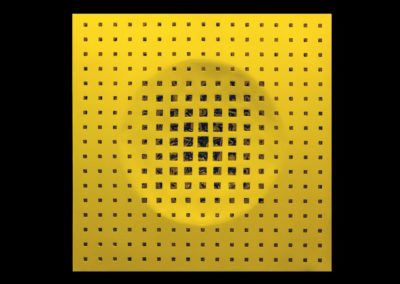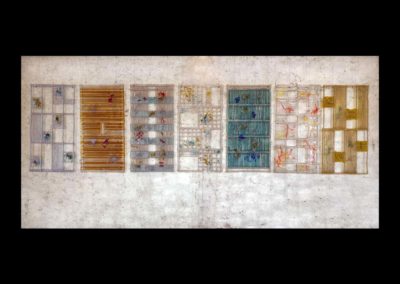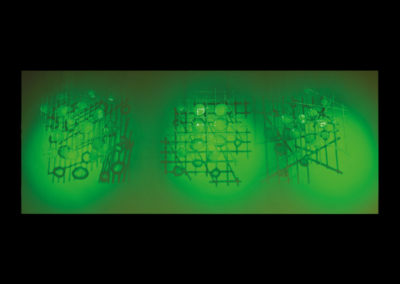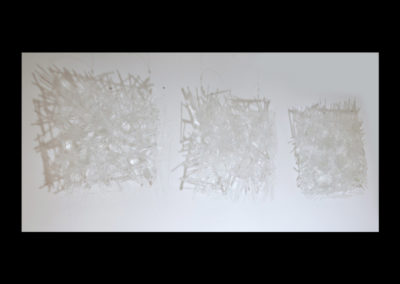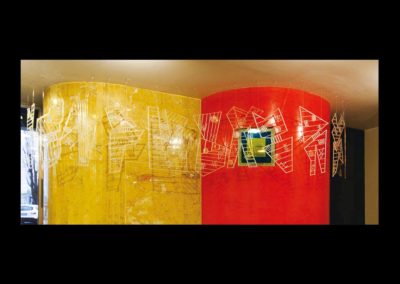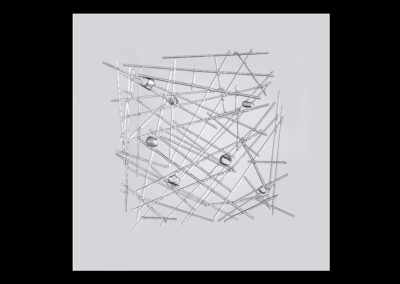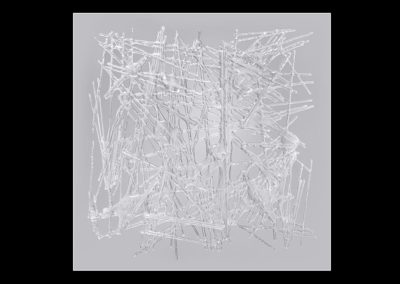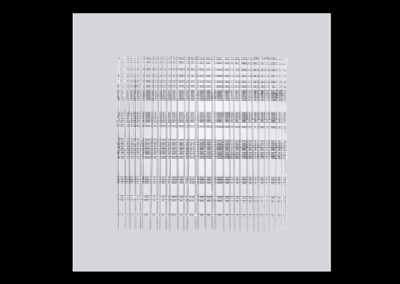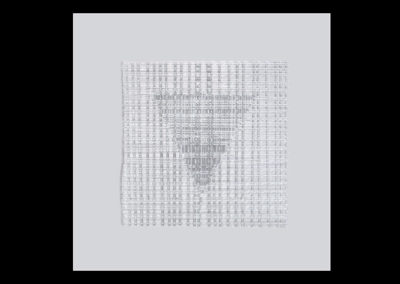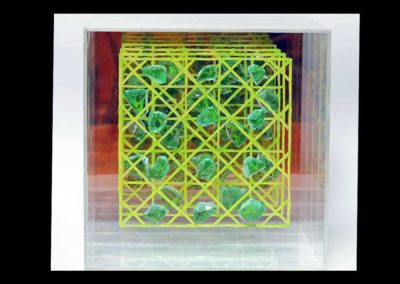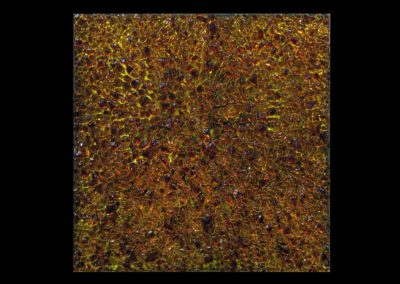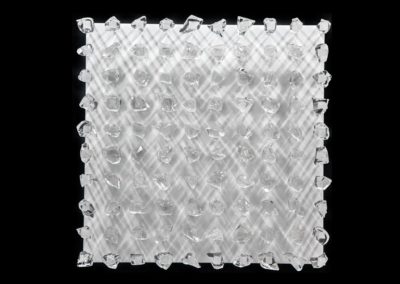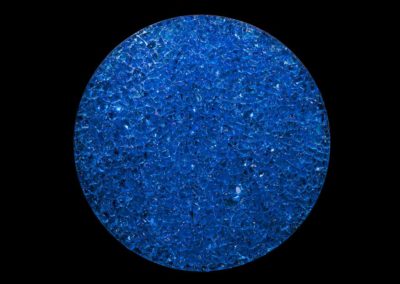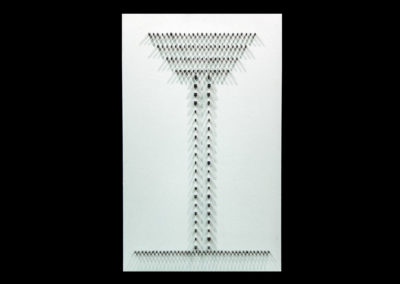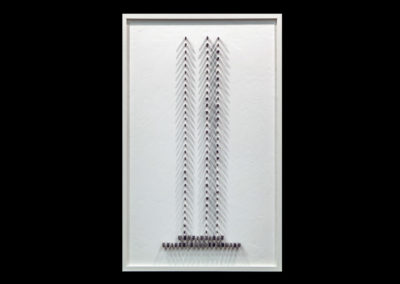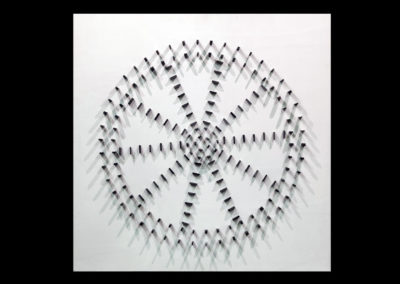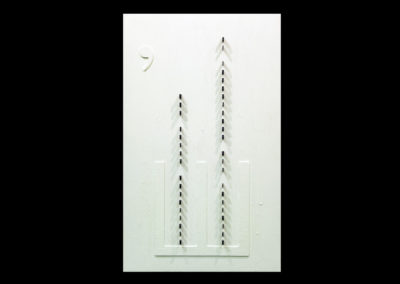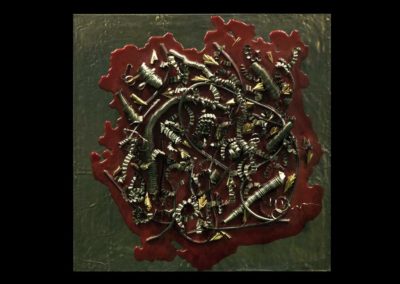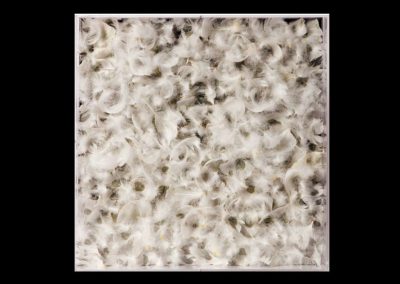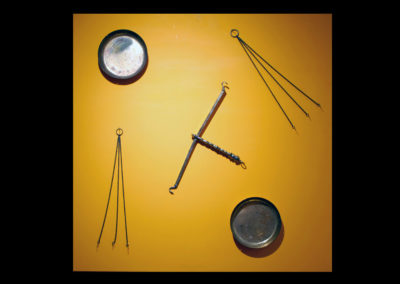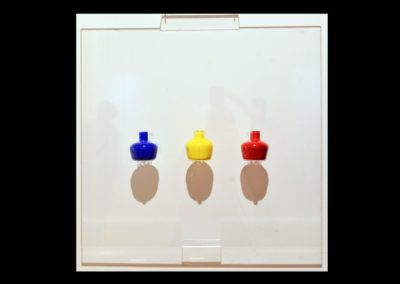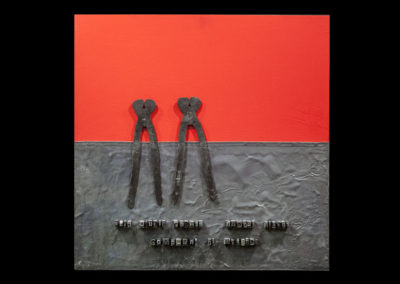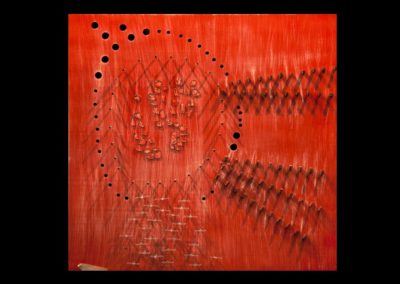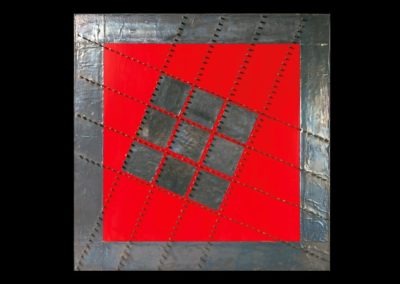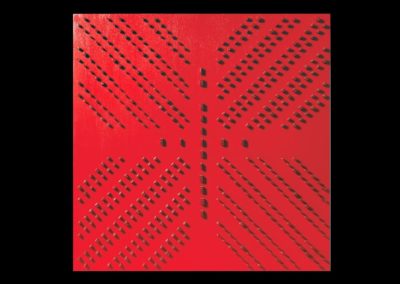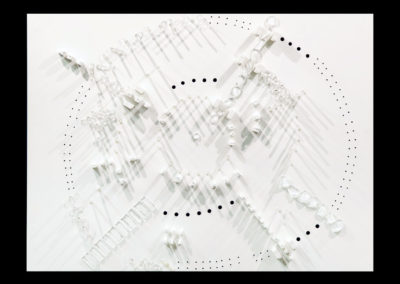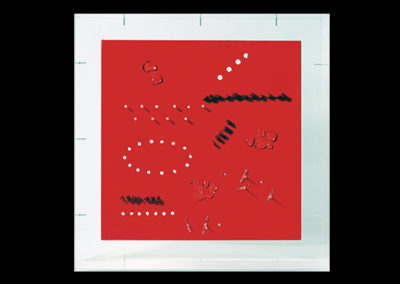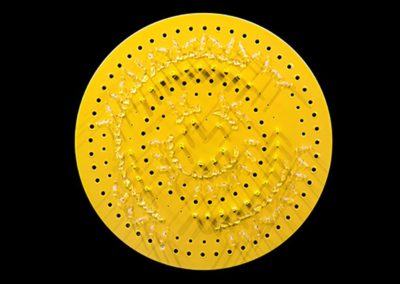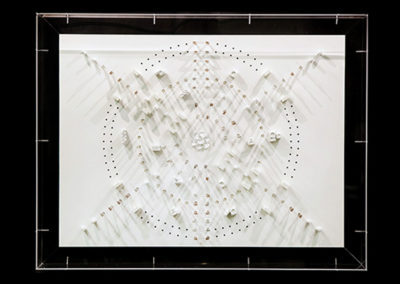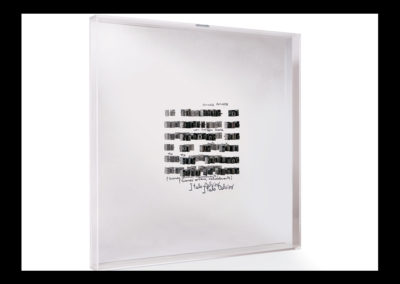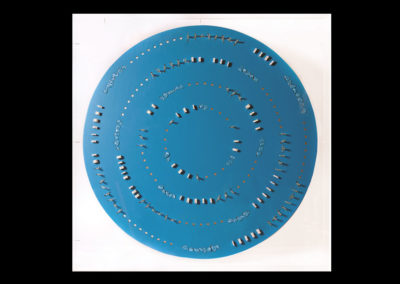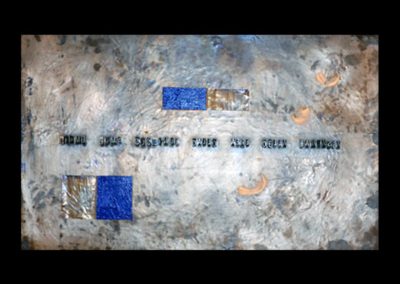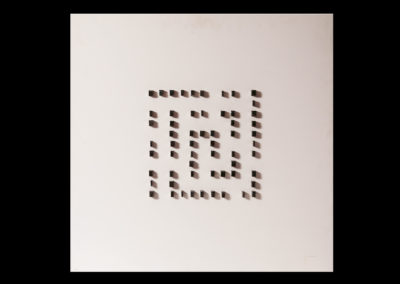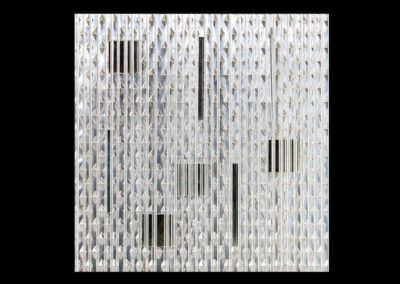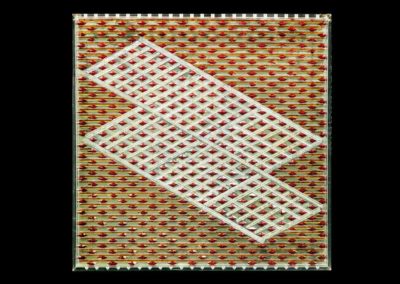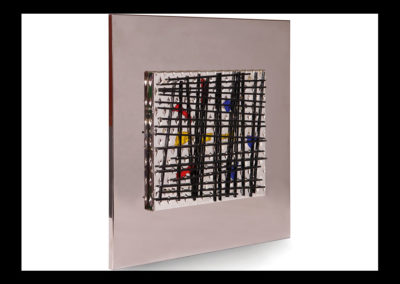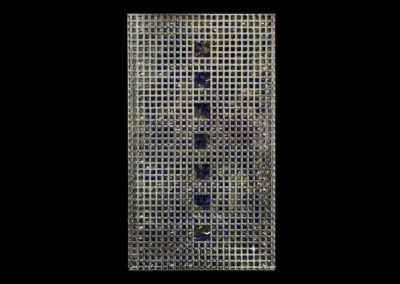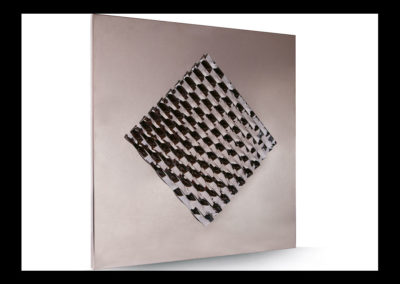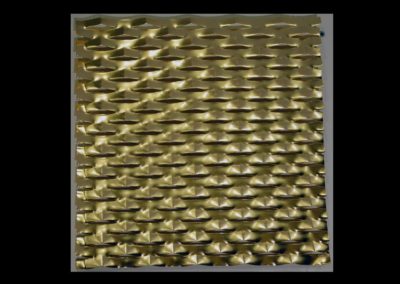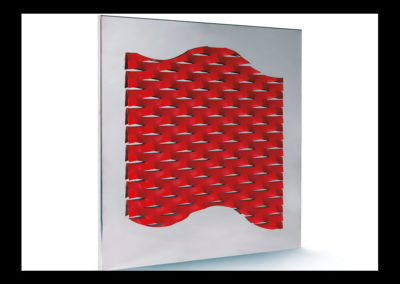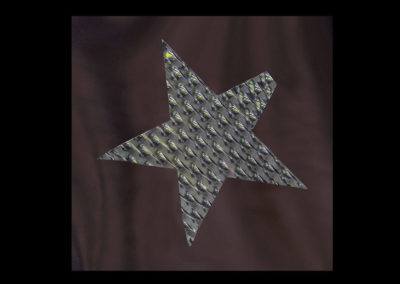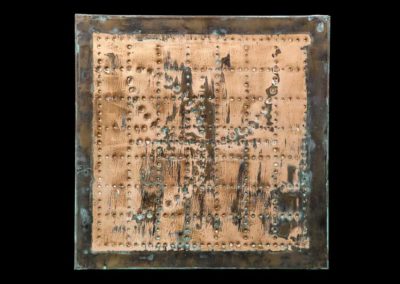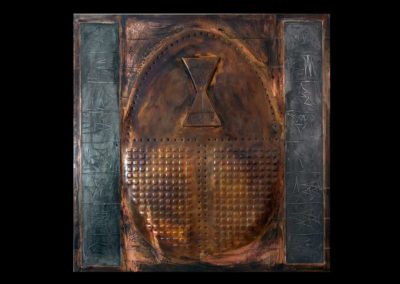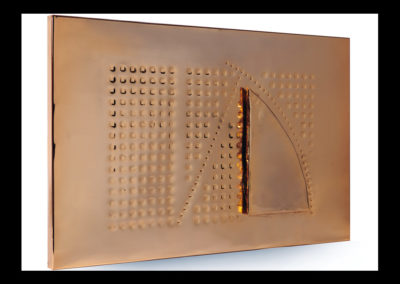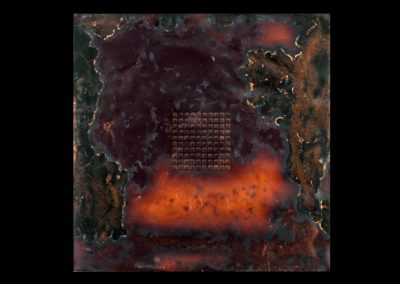SCULPTING LIGHTNS AND LIGHT
This series shows the products of the long search that led the artist to question the value of works of art. A laser-perforated Plexiglas plate describes shapes and figures using the emptiness of the spaces cut. The pieces removed by the perforation are fixed to a piece of sheet metal of the same size just 4 centimetres behind the Plexiglas, creating a second design that copies the first, in relief. Together they form a box in the air, which is as mutable as the light that changes with the mutations in the sheet metal, as ethereal as the drawing’s shadows and reflections that distort the interpretation of the planes of the composition, questioning the symbiotic relationship between physical and metaphysical elements.
This series shows the products of the long search that led the artist to question the value of works of art. A laser-perforated Plexiglas plate describes shapes and figures using the emptiness of the spaces cut. The pieces removed by the perforation are fixed to a piece of sheet metal of the same size just 4 centimetres behind the Plexiglas, creating a second design that copies the first, in relief. Together they form a box in the air, which is as mutable as the light that changes with the mutations in the sheet metal, as ethereal as the drawing’s shadows and reflections that distort the interpretation of the planes of the composition, questioning the symbiotic relationship between physical and metaphysical elements.
Series inspired by the priceless refinementof the stained glass windows of Venetian palaces. The panel,clad with fragments of glass,beyond thegrille of the sculptures, reflects and fragments the outside world. The light, having penetrated the cuts in the first surface,remains trapped in the space delimited by the Plexiglas box, transcendsreality with optical illusions and chromodynamicsand interacts with the crystals and resins, thus contributing to the creation of a second virtual reality that the artist wishes to unveil before us.
Series inspired by the priceless refinementof the stained glass windows of Venetian palaces. The panel,clad with fragments of glass,beyond thegrille of the sculptures, reflects and fragments the outside world. The light, having penetrated the cuts in the first surface,remains trapped in the space delimited by the Plexiglas box, transcendsreality with optical illusions and chromodynamicsand interacts with the crystals and resins, thus contributing to the creation of a second virtual reality that the artist wishes to unveil before us.
Light cotton threads hanging, but free to flutter in the air, or steel wires and nylon lines, stretched between tie-rods, identify, on the first surface of the work – sometimes white, sometimes modified by chromatic backgrounds – a second aerial structure, unbound from the first but still dependent on it, created by significant points in an abstract design. The clear, direct segments traced by the threads mark linear routes that create an absent, barely hinted at pictorial shape.
Light cotton threads hanging, but free to flutter in the air, or steel wires and nylon lines, stretched between tie-rods, identify, on the first surface of the work – sometimes white, sometimes modified by chromatic backgrounds – a second aerial structure, unbound from the first but still dependent on it, created by significant points in an abstract design. The clear, direct segments traced by the threads mark linear routes that create an absent, barely hinted at pictorial shape.
Light and shadow suspended among full and empty, relating nothingness to everything, stating the presence of the work through its negation, discerning the perfect, harmonic relation between heaviness and lightness. “Lightness is not removing weight by removing superfluous elements from the work of art” –the artist pointed out – “rather it is succeeding in giving shape to an idea that appears not only light, but also in movement, inventive, and imaginative.”
Light and shadow suspended among full and empty, relating nothingness to everything, stating the presence of the work through its negation, discerning the perfect, harmonic relation between heaviness and lightness. “Lightness is not removing weight by removing superfluous elements from the work of art” –the artist pointed out – “rather it is succeeding in giving shape to an idea that appears not only light, but also in movement, inventive, and imaginative.”
The Energiaservizi srl Company asked the artist to design a solar panel different from the usual. The artist designed a square panel calledModulo Quadro (Square Module), which produces energy during the day andat night, lights up the figure drawn on the panel. Thepanel was designed to be installed on the front of dwellings as an identifying imagein the same mannerthat fishermen from Burano would, and still do today, paint thefacades of their houses with strong, vivid colours.
The Energiaservizi srl Company asked the artist to design a solar panel different from the usual. The artist designed a square panel calledModulo Quadro (Square Module), which produces energy during the day andat night, lights up the figure drawn on the panel. Thepanel was designed to be installed on the front of dwellings as an identifying imagein the same mannerthat fishermen from Burano would, and still do today, paint thefacades of their houses with strong, vivid colours.
FIREFLY SWARM 2017
Hemisphere; diameter: 3 m
This sculpture was built by placing around thirty revolving chimney caps made of mirror-polished stainless steel on a steel framework. Inside each cap, there is a small LEDlamp that lights up at night. The caps,pushed by air, rotate. When it is dark, the caps are illuminated by the lamps and produce quivering sparkles, thus looking like a flying swarm of fireflies.
FIBONACCI 2017
Mirror-polished stainless steel, 2 x1.80x 4.30 m in height
In order to create the basic shape of the sculpture, which represents a tree, the artist thought of a shape similar to that which depicts the Fibonacci Sequence. The leaves are symbolized by mirror-polished steel revolving chimney caps.
JUSTICE 2014
Corten steel, 0.70x 0.70 x 3.40 m height
This sculpture represents a tower built using 18 small cages (. 15x 15 x 15cm), each supporting a larger cage (70 x 70 x 70cm.) Inside each cage is a scale with different pans, held balanced by different weights.
BASTIANI FORTRESS 2012
Painted stainless steel. This sculpture group, placed in a 2.50 m x 2.50 m square, consists of six elements, each 4 metres high. Inspired by the Dino Buzzati novel,The Tartar Steppe, Bastiani Fortress was conceived as if located at the edge of a surreal, metaphorical desert, lost, beyond time and space, in a surreal dimension where nothing has any true meaning.
FIREFLY SWARM 2017
Hemisphere; diameter: 3 m
This sculpture was built by placing around thirty revolving chimney caps made of mirror-polished stainless steel on a steel framework. Inside each cap, there is a small LEDlamp that lights up at night. The caps,pushed by air, rotate. When it is dark, the caps are illuminated by the lamps and produce quivering sparkles, thus looking like a flying swarm of fireflies.
FIBONACCI 2017
Mirror-polished stainless steel, 2 x1.80x 4.30 m in height
In order to create the basic shape of the sculpture, which represents a tree, the artist thought of a shape similar to that which depicts the Fibonacci Sequence. The leaves are symbolized by mirror-polished steel revolving chimney caps.
JUSTICE 2014
Corten steel, 0.70x 0.70 x 3.40 m height
This sculpture represents a tower built using 18 small cages (. 15x 15 x 15cm), each supporting a larger cage (70 x 70 x 70cm.) Inside each cage is a scale with different pans, held balanced by different weights.
BASTIANI FORTRESS 2012
Painted stainless steel. This sculpture group, placed in a 2.50 m x 2.50 m square, consists of six elements, each 4 metres high. Inspired by the Dino Buzzati novel,The Tartar Steppe, Bastiani Fortress was conceived as if located at the edge of a surreal, metaphorical desert, lost, beyond time and space, in a surreal dimension where nothing has any true meaning.
Concave and convex shapes of hemispheric or ellipsoidal volumes are fluid, vital materialsthat expand in space; they come forth out of the two-dimensional plane and appear gradually in the environment in the form of monochrome or bichrome extraflections and introflections to reveal new angles of observation, new considerations and to foster symbolic visual intrusions towards the pulsing heart of the opus.
Concave and convex shapes of hemispheric or ellipsoidal volumes are fluid, vital materialsthat expand in space; they come forth out of the two-dimensional plane and appear gradually in the environment in the form of monochrome or bichrome extraflections and introflections to reveal new angles of observation, new considerations and to foster symbolic visual intrusions towards the pulsing heart of the opus.
Big, square, rectangular and irregularpanels, made of glass laths and white or coloured crystals, heat-processed using a glass fusing technique, give the artist the pretext to introducea narrative element,usually absent in his works, to his research. Juxtaposed along the walls of the exhibition rooms,thepanels tell stories (Ali Baba and the Forty Thieves), simulate natural phenomena (clouds), and recall joyful and light-hearted times (children’s play).).
Big, square, rectangular and irregularpanels, made of glass laths and white or coloured crystals, heat-processed using a glass fusing technique, give the artist the pretext to introducea narrative element,usually absent in his works, to his research. Juxtaposed along the walls of the exhibition rooms,thepanels tell stories (Ali Baba and the Forty Thieves), simulate natural phenomena (clouds), and recall joyful and light-hearted times (children’s play).
The tendency toward abstraction of shapes, the search for minimal constructs, the geometric simplification of significant elements that characterise the artist’s poetics, bring these figurative and expressive languages closer to the world of music whose structural and harmonic rules appear to support and determine the compositions.
The tendency toward abstraction of shapes, the search for minimal constructs, the geometric simplification of significant elements that characterise the artist’s poetics, bring these figurative and expressive languages closer to the world of music whose structural and harmonic rules appear to support and determine the compositions.
Frequently found in many of the artist’s works, white or colouredglass rods first create a conceptual and visual barrier in front of the work’s background.Placed linearly on the surface of sculptures, they mark a clear separation between the work of art and its double – life. Then, melting the glass rods, the artist created an even denser, apparently impenetrablegrid, but which is instead open to luminous reverberations and infiltrations.
Frequently found in many of the artist’s works, white or colouredglass rods first create a conceptual and visual barrier in front of the work’s background.Placed linearly on the surface of sculptures, they mark a clear separation between the work of art and its double – life. Then, melting the glass rods, the artist created an even denser, apparently impenetrablegrid, but which is instead open to luminous reverberations and infiltrations.
Cotisso are bits of coloured glass from Murano glassworks waste that has been melted and combined in an infinite variation, and applied using resin on the mirror or Plexiglas surfaces of sculptures. This material reverberates, amplifies and fragments the external light that illuminates the work of art.Using this material, the luminous element becomes the privileged interlocutor of each work of art.
Cotisso are bits of coloured glass from Murano glassworks waste that has been melted and combined in an infinite variation, and applied using resin on the mirror or Plexiglas surfaces of sculptures. This material reverberates, amplifies and fragments the external light that illuminates the work of art.Using this material, the luminous element becomes the privileged interlocutor of each work of art.
In refusing to be stereotyped(and in his need to seek archetypical figurative forms) there emerges the artist’s investigative paradigm, that is, his tension towards formal purity, for expressive immediacy, his need for synthesis, perhaps even for the demystification of the same work of art.
In refusing to be stereotyped(and in his need to seek archetypical figurative forms) there emerges the artist’s investigative paradigm, that is, his tension towards formal purity, for expressive immediacy, his need for synthesis, perhaps even for the demystification of the same work of art.
PROJECTs
In the artist’s empirical research on manydifferent materials he has conducted in his studio,some (metals, Plexiglas, typographical symbols, glass) have become crucial elements of an original artistic poetic. Others, instead, (feathers, metal swarf and scrap, glass bottles)are compositional elements in works left unfinished, prototypes in potential abeyancefor future development.
PROJECTs
In the artist’s empirical research on manydifferent materials he has conducted in his studio,some (metals, Plexiglas, typographical symbols, glass) have become crucial elements of an original artistic poetic. Others, instead, (feathers, metal swarf and scrap, glass bottles)are compositional elements in works left unfinished, prototypes in potential abeyancefor future development.
On pictorial backgroundscharacterised by intense reds, thesimple, immediate geometric planesof the grids found in Roman camps are laid out along orthogonal axes with lead type letterspartitioning and enclosing the artist’s ideas inside of defined physical spaces andhis thoughts on human history, becoming a narrative pretext to reveal and question the violenceperpetrated by each culture. The ordered structure of the composition reminds the viewer of the orderly disposition of military bivouacs.
Gaio Giulio Cesare e Adolf Hitler compagni di merende 2013
cm 84x84x5 – Tongue lead typographical characters
On pictorial backgroundscharacterised by intense reds, thesimple, immediate geometric planesof the grids found in Roman camps are laid out along orthogonal axes with lead type letterspartitioning and enclosing the artist’s ideas inside of defined physical spaces andhis thoughts on human history, becoming a narrative pretext to reveal and question the violenceperpetrated by each culture. The ordered structure of the composition reminds the viewer of the orderly disposition of military bivouacs.
Agglomerations of glass crystals, lead types, and glass rods, hammered on the plastic substrates of sculptures, together with the holes on the surface of the works, sketch the perimeters and outline the urban developments of feasible and utopic cities.
Agglomerations of glass crystals, lead types, and glass rods, hammered on the plastic substrates of sculptures, together with the holes on the surface of the works, sketch the perimeters and outline the urban developments of feasible and utopic cities.
ITALO CALVINO
I am still one of those people who believe, like Croce, that it is only an artist’s work that counts. If it counts at all, naturally.
J.M. BARRIE
God gave us memory so that we might have roses in December.
CONFUCIUS
Stars are holes in the sky from which the light of the infinite shines.
FEATHERS
Feathers pushed gently by the wind of fantasy.
ITALO CALVINO
I am still one of those people who believe, like Croce, that it is only an artist’s work that counts. If it counts at all, naturally.
J.M. BARRIE
God gave us memory so that we might have roses in December.
CONFUCIUS
Stars are holes in the sky from which the light of the infinite shines.
FEATHERS
Feathers pushed gently by the wind of fantasy.
The use of lead and wood moveable type, no longer used with the advent of computersand digital processing, has been rediscovered and used by the artist in many works belonging to this fundamental research cycle.The beauty of moveable type, homage to the printing press invented by Johannes Gutenberg,retrieves the objects by virtue of their innate aesthetic potential, thus shaping abstract images, of absolute value and “linking the Renaissance to the 21stcentury”, as the artist explained.
The use of lead and wood moveable type, no longer used with the advent of computersand digital processing, has been rediscovered and used by the artist in many works belonging to this fundamental research cycle.The beauty of moveable type, homage to the printing press invented by Johannes Gutenberg,retrieves the objects by virtue of their innate aesthetic potential, thus shaping abstract images, of absolute value and “linking the Renaissance to the 21stcentury”, as the artist explained.
Non-slip sheetmetal, industrially manufactured from many materialswith diamond-shaped reliefs giving them greater stiffness and resistance to traffic and slipping,are mainly used for walkways. Because of the diamond-shaped relief, they vaguely resemble Castellani’s extroflexed canvasses. Not only do these sheets make the viewer impulsively long to touch them, but they also offer the artist the opportunity to question the principles of aesthetic self-referentiality of the artistic product.
Non-slip sheetmetal, industrially manufactured from many materialswith diamond-shaped reliefs giving them greater stiffness and resistance to traffic and slipping,are mainly used for walkways. Because of the diamond-shaped relief, they vaguely resemble Castellani’s extroflexed canvasses. Not only do these sheets make the viewer impulsively long to touch them, but they also offer the artist the opportunity to question the principles of aesthetic self-referentiality of the artistic product.
The use of this material, from the construction industry, enabled the artist to begin to ponder on this artistic object and its latent expressive validity, on its intrinsic beauty and its potential communicative significance. It is one of Duchamp’s “objet trouvé”, selected by the artist because it is beautiful in and of itself due to its own innate aesthetic features.
The use of this material, from the construction industry, enabled the artist to begin to ponder on this artistic object and its latent expressive validity, on its intrinsic beauty and its potential communicative significance. It is one of Duchamp’s “objet trouvé”, selected by the artist because it is beautiful in and of itself due to its own innate aesthetic features.
Foil made of zinc, aluminium, lead, copper and brass has been worked in repoussé and engraved, as well as occasionally modified by fire or corrosive acids. These sheets of foil tell stories characterized by alchemical elements and philosophical thoughts. By accepting the marks impressed onto them by the artist, who alters them, their structures highlight theintrinsic beauty of the material.
Foil made of zinc, aluminium, lead, copper and brass has been worked in repoussé and engraved, as well as occasionally modified by fire or corrosive acids. These sheets of foil tell stories characterized by alchemical elements and philosophical thoughts. By accepting the marks impressed onto them by the artist, who alters them, their structures highlight theintrinsic beauty of the material.
